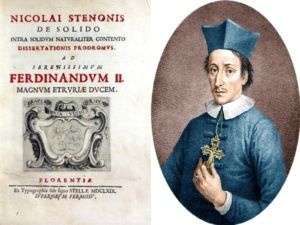Business & Education
Steno – Denmark’s ninth Saint comes marching in …
This article is more than 9 years old.
Niels Steensen, alias Steno, was a 17th century scientist and bishop who became Denmark’s first saint in 500 years after being beatified by Pope John Paul II at a ceremony in the Vatican in 1988. Now, he awaits the statutory two miracles before achieving canonisation, as decreed by the Catholic Church

Steno studied medicine during the plague years and converted to Catholicism at the age of 39 (photo: Steno and JP Trap)
The beatification of Niels Steensen caused a stir in mainly Protestant Denmark when it was announced before the pope’s historic tour of five Nordic countries in 1989 – the first papal visit ever to a region that is a bastion of Lutheranism.
Steensen – an anatomist, scientist, geologist and philosopher – was born in Copenhagen in 1638 to die in poverty as a bishop in 1686 after converting to Catholicism.
While extreme Lutherans adopted a negative attitude to Steno’s beatification, the average Danish Christian welcomed the event as a chance to gain a new understanding of the Catholic Church and consider the connection between Protestantism and Catholicism. In 1985, however, the theological faculty at Copenhagen University refused to participate in ceremonies marking the 300th anniversary of Steensen’s death because he was not a Lutheran.
Around 75 percent of Danes are members of the Evangelical Lutheran State Church, and less than 10 percent are regular church-goers. Catholic numbers have slipped below 35,000, less than 1 percent of Denmark’s 5.6 million population.
Praying for a miracle
Following Pope John Paul II’s confirmation, Erik Christiansen of Denmark’s Catholic Diocesan Office said it would require the necessary two miracles before Steensen was finally canonised, adding that most candidates only reach beatification.
“The most important thing is that Steensen has been beatified, but our faith stipulates that two miracles are now required for him or any other candidate to achieve canonisation and that could take centuries,” said Christiansen.
“Steensen is a most suitable candidate for canonisation today – he had an utterly modern approach to science, with a cool, almost clinical, but unfailingly positive belief in science as the prime means of extending the boundaries of mankind’s knowledge. Over and above his prowess as a scientist, Steensen was also endowed with a deep sense of religious awe.”
In a lecture in 1673 at the opening of the Anatomical Theatre in Copenhagen, Steensen said: “Beauty is that which we see, more beautiful is that which we know, but the most beautiful is that of which we are ignorant.”
Glands to God fearing
Steensen is known in Latin as Nicolaus/Nicolas Steno and he has been allocated 25 November as his saint’s day. In the Danish capital there is a Steno Hospital, a Steno Pharmacy and a Steno Street (Stenogade in west-end Vesterbro). He was an important anatomist and studied the mechanics of the human brain, the heart, muscle geometry and glands. Steensen conducted research into the parotid gland, a large salivary gland situated in front of and below each ear and connected to the mouth – a link unknown to medicine before. The gland is called in medical parlance the Ductus Stenonianus – after the discoverer himself.
In the field of geology, Steensen conducted extensive studies of fossils and established their importance in learning about prehistoric animal and human life.
Born in Copenhagen 378 years ago, Steensen spent most of his life outside his native country. He initially studied medicine at the University of Copenhagen during the turbulent years when the plague killed a third of the population.
Also as a student, he and his peers had to man the city walls to fight off the Swedish invasion, continuing his studies of anatomy in the Netherlands, France and Italy before converting to Catholicism in Florence at the age of 39. He corresponded with philosophers René Descartes of France and Gottfried Wilhelm Leibniz of Germany and was a close friend of the Dutch metaphysical thinker Baruch Spinoza.
Final fare to Florence
His enquiring nature also led to him studying the foundations of his Christian faith. This faith was intimately linked to his work as a scientist, and after thorough theological studies, and with the encouragement of good friends, he was ordained as a priest and bishop and sent to the northern part of Germany, working in Hannover, Munster, Hamburg and Schwerin.
Steensen died in Schwerin in 1686 after several years of pastoral service, and his corpse was moved to Italy where it was buried in a sarcophagus in the San Lorenzo basilica, Florence.
Denmark, a stronghold of Lutheranism since the Protestant Reformation in the 16th century, has boasted only eight canonised saints in 1,000 years of Christianity. The last Dane to be canonised was a Franciscan monk called Villehad in the 16th century.










































